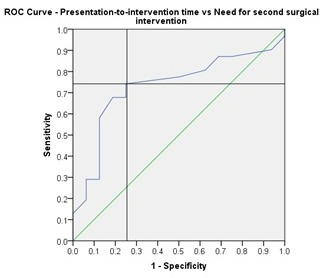Back


Poster Session A - Sunday Afternoon
Category: Colon
A0091 - Is There a "Golden Window" for Endoscopic Reduction of Acute Sigmoid Volvulus: A Multicenter Retrospective Study"
Sunday, October 23, 2022
5:00 PM – 7:00 PM ET
Location: Crown Ballroom

Has Audio

Husam Bader, MD
Monmouth Medical Center
Long Branch, NJ
Presenting Author(s)
Husam Bader, MD1, Amer Abu-Shanab, MD2, Mohammad Darweesh, MD3, Faisal M. Nimri, MBBS4, Ratib Mahfouz, MD5, Raghu Tiperneni, MD6, Poonam Raut, MD6, Vishakha Sirpal, MD7, Mubarak Sayyar, MD8
1Monmouth Medical Center, Eatontown, NJ; 2University of Jordan, Amman, 'Amman, Jordan; 3East Tennessee State University, Johnson City, TN; 4Henry Ford Hospital, Detroit, MI; 5Brown University/Kent Hospital, Providence, RI; 6Monmouth Medical Center, Long Branch, NJ; 7Monmouth Medical Center/RWJBH, Long Branch, NJ; 8Presbyterian Medical Center, Albuquerque, NM
Introduction: Colonic volvulus accounts for around 2% of all bowel obstructions in the United States. the involvement of the sigmoid colon consists of the overwhelming majority of colonic volvulus cases, possibly 60.9–80%. [1]. Per the American Society of Gastrointestinal endoscopy guidelines (ASGE), Non-operative detorsion with flexible sigmoidoscopy is considered first-line therapy in the management of sigmoid volvulus in patients without signs of peritonitis, perforation, or with recurrent or unsuccessful nonoperative decompression [2][3][4]. Despite this recommendation, the ideal timing for endoscopic intervention remains unclear.
Methods: We conducted a retrospective study in adult patients admitted for acute sigmoid volvulus in 4 academic centers from January/2010-January/2020. 47 Patients were identified using ICD-9 and ICD-10 codes. Inclusion criteria included adult patients who were initially managed with endoscopic detorsion. The time interval between diagnosis and endoscopic intervention was collected. Primary outcomes included the need for subsequent urgent surgical intervention within 30 days of the endoscopic intervention. Secondary outcomes were hospital length of stay and mortality.
Results: A total of 47 patients met the inclusion criteria. 33 patients were males (70.2%). The mean age of the sample was 71.0 (±16.5) years. Successful non-surgical reduction was achieved in 43 patients (91.5%). Endoscopic intervention was aborted in 4 patients for concerns of bowel ischemia or nonviable mucosa. 31 (66%) patients required urgent surgical intervention within 30 days of the endoscopic reduction, with an average interval period of 7 (±8.5) days. Surgical interventions included Hartmann’s procedure, sigmoid colectomy with primary colorectal anastomosis, and total abdominal colectomy.
Early endoscopic reduction resulted in fewer subsequent urgent and emergent surgical interventions (p-value = 0.013). Using the ROC curve, a cut-off point of 8.5 hours was determined to be predictable of favorable outcomes with a sensitivity and specificity of 74.2%, and 75%, respectively. (Figure 1). Early endoscopic intervention was associated with shorter hospitalization (p-value = 0.001).
Discussion: Endoscopic decompressive intervention within 8.5 hours of diagnosis of acute sigmoid volvulus decreased early volvulus recurrence, bowel ischemia and subsequent need for urgent surgical interventions. This in return decreased hospital length of stay and allowed for planned prophylactic surgical resection.

Disclosures:
Husam Bader, MD1, Amer Abu-Shanab, MD2, Mohammad Darweesh, MD3, Faisal M. Nimri, MBBS4, Ratib Mahfouz, MD5, Raghu Tiperneni, MD6, Poonam Raut, MD6, Vishakha Sirpal, MD7, Mubarak Sayyar, MD8. A0091 - Is There a "Golden Window" for Endoscopic Reduction of Acute Sigmoid Volvulus: A Multicenter Retrospective Study", ACG 2022 Annual Scientific Meeting Abstracts. Charlotte, NC: American College of Gastroenterology.
1Monmouth Medical Center, Eatontown, NJ; 2University of Jordan, Amman, 'Amman, Jordan; 3East Tennessee State University, Johnson City, TN; 4Henry Ford Hospital, Detroit, MI; 5Brown University/Kent Hospital, Providence, RI; 6Monmouth Medical Center, Long Branch, NJ; 7Monmouth Medical Center/RWJBH, Long Branch, NJ; 8Presbyterian Medical Center, Albuquerque, NM
Introduction: Colonic volvulus accounts for around 2% of all bowel obstructions in the United States. the involvement of the sigmoid colon consists of the overwhelming majority of colonic volvulus cases, possibly 60.9–80%. [1]. Per the American Society of Gastrointestinal endoscopy guidelines (ASGE), Non-operative detorsion with flexible sigmoidoscopy is considered first-line therapy in the management of sigmoid volvulus in patients without signs of peritonitis, perforation, or with recurrent or unsuccessful nonoperative decompression [2][3][4]. Despite this recommendation, the ideal timing for endoscopic intervention remains unclear.
Methods: We conducted a retrospective study in adult patients admitted for acute sigmoid volvulus in 4 academic centers from January/2010-January/2020. 47 Patients were identified using ICD-9 and ICD-10 codes. Inclusion criteria included adult patients who were initially managed with endoscopic detorsion. The time interval between diagnosis and endoscopic intervention was collected. Primary outcomes included the need for subsequent urgent surgical intervention within 30 days of the endoscopic intervention. Secondary outcomes were hospital length of stay and mortality.
Results: A total of 47 patients met the inclusion criteria. 33 patients were males (70.2%). The mean age of the sample was 71.0 (±16.5) years. Successful non-surgical reduction was achieved in 43 patients (91.5%). Endoscopic intervention was aborted in 4 patients for concerns of bowel ischemia or nonviable mucosa. 31 (66%) patients required urgent surgical intervention within 30 days of the endoscopic reduction, with an average interval period of 7 (±8.5) days. Surgical interventions included Hartmann’s procedure, sigmoid colectomy with primary colorectal anastomosis, and total abdominal colectomy.
Early endoscopic reduction resulted in fewer subsequent urgent and emergent surgical interventions (p-value = 0.013). Using the ROC curve, a cut-off point of 8.5 hours was determined to be predictable of favorable outcomes with a sensitivity and specificity of 74.2%, and 75%, respectively. (Figure 1). Early endoscopic intervention was associated with shorter hospitalization (p-value = 0.001).
Discussion: Endoscopic decompressive intervention within 8.5 hours of diagnosis of acute sigmoid volvulus decreased early volvulus recurrence, bowel ischemia and subsequent need for urgent surgical interventions. This in return decreased hospital length of stay and allowed for planned prophylactic surgical resection.

Figure: Figure 1
Disclosures:
Husam Bader indicated no relevant financial relationships.
Amer Abu-Shanab indicated no relevant financial relationships.
Mohammad Darweesh indicated no relevant financial relationships.
Faisal Nimri indicated no relevant financial relationships.
Ratib Mahfouz indicated no relevant financial relationships.
Raghu Tiperneni indicated no relevant financial relationships.
Poonam Raut indicated no relevant financial relationships.
Vishakha Sirpal indicated no relevant financial relationships.
Mubarak Sayyar indicated no relevant financial relationships.
Husam Bader, MD1, Amer Abu-Shanab, MD2, Mohammad Darweesh, MD3, Faisal M. Nimri, MBBS4, Ratib Mahfouz, MD5, Raghu Tiperneni, MD6, Poonam Raut, MD6, Vishakha Sirpal, MD7, Mubarak Sayyar, MD8. A0091 - Is There a "Golden Window" for Endoscopic Reduction of Acute Sigmoid Volvulus: A Multicenter Retrospective Study", ACG 2022 Annual Scientific Meeting Abstracts. Charlotte, NC: American College of Gastroenterology.
